Allium tricoccum (Wild Leek)
| Also known as: | Ramps, Three-seeded Leek |
|---|---|
| Genus: | Allium |
| Family: | Alliaceae (Onion) |
| Life cycle: | perennial |
| Origin: | native |
| Habitat: | part shade, shade; moist rich woods |
| Bloom season: | June - July |
| Plant height: | 6 to 9 inches |
| Wetland Indicator Status: | GP: FACU MW: FACU NCNE: FACU |
| MN county distribution (click map to enlarge): | 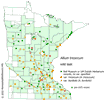 |
| National distribution (click map to enlarge): |  |
Pick an image for a larger view. See the glossary for icon descriptions.
Detailed Information
Flower: 

![[photo of flowers]](/udata/r9ndp23q/pd/allium-tricocum-2907678-3-t.jpg) Small round cluster of ¼-inch creamy or greenish white flowers on stout stalks about 1¼ inch long, with 2 papery bracts at the base of the cluster. Flowers have 6 tepals (petals), 6 stamens with creamy yellow tips, and a green overy with 3 globular sections in the center. Flowers appear 4 to 6 weeks after leaves have emerged, usually after they have withered away for the season.
Small round cluster of ¼-inch creamy or greenish white flowers on stout stalks about 1¼ inch long, with 2 papery bracts at the base of the cluster. Flowers have 6 tepals (petals), 6 stamens with creamy yellow tips, and a green overy with 3 globular sections in the center. Flowers appear 4 to 6 weeks after leaves have emerged, usually after they have withered away for the season.
Leaves and stem: 

![[photo of leaves]](/udata/r9ndp23q/green/wild-leek_0504_112905-t.jpg) 2 or 3 three basal leaves emerge from an underground bulb in early spring, 6 to 12 inches long, 1 to 4 inches wide, lance-elliptic, narrowed at both ends with a long tappered base, smooth leathery texture with faint parallel veins, toothless, dark green often tinged red at the base with a reddish stalk. The flowering stalk is smooth and green or reddish, and starts emerging as the leaves wither away for the season.
2 or 3 three basal leaves emerge from an underground bulb in early spring, 6 to 12 inches long, 1 to 4 inches wide, lance-elliptic, narrowed at both ends with a long tappered base, smooth leathery texture with faint parallel veins, toothless, dark green often tinged red at the base with a reddish stalk. The flowering stalk is smooth and green or reddish, and starts emerging as the leaves wither away for the season.
Fruit: 
![[photo of fruit]](/udata/r9ndp23q/pd/allium-tricoccum_970-1-t.jpg) Fruit is a 3-celled glossy black capsule, each cell containing 1 seed.
Fruit is a 3-celled glossy black capsule, each cell containing 1 seed.
Notes:
A denizen of deep shady woods, Wild Leek can form thick colonies of lush green leaves in early spring but flowers are small and diminuative by comparson and often go unnoticed while in the presence of later summer species. Leaves and flowers both have a strong onion odor, especially when bruised. There are 2 varieties, both found in Minnesota. Var. tricoccum has broader leaves commonly reddish at the base and up to 50 flowers in a cluster. Var. burdickii has narrower leaves green at the base and is shorter stalked, with 20 or fewer flowers per cluster. All Allium species were formerly in the Liliaceae (Lily) family, but are now in Alliaceae (Onion).
Native Plant Nurseries, Restoration and Landscaping Services ↓
More photos
 a colony of Wild Leek in early spring
a colony of Wild Leek in early spring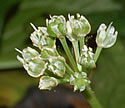 Wild Leek with Skunk Cabbage
Wild Leek with Skunk Cabbage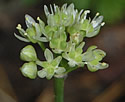 more flowers
more flowers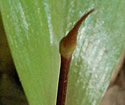 emerging flower
emerging flower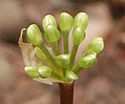 budding flower
budding flower var. burdickii leaves
var. burdickii leaves
Photos by K. Chayka taken in Ramsey, Washington and Chisago counties. Photos courtesy Peter M. Dziuk taken in Anoka County.
Comments
Have you seen this plant in Minnesota, or have any other comments about it?
on: 2011-04-15 13:35:01
Clusters with 6" leaves found along the Zumbro River - south Rochester
on: 2012-08-03 13:55:16
Spotted this plant in the woods in early July, no leaves, just stems with finished flowers.
on: 2014-05-19 21:14:44
The only green thing in the forest along the trail between Oberg Mtn and Sawbill Creek. Strong garlic smell! Smelled like a hamburger stand.
on: 2014-06-04 08:07:00
I have a wooded back yard which I have left as natual as possible and in the spring, the area under the trees is carpeted with them. Jack in the pulpit, a few trillium. Solomon's seal, false Solomon's seal along with yellow and purple violets emerge as well.
on: 2015-04-11 22:54:38
I'm curious how to tell ramps from bluebead lilies when just the leaves are showing. They both have pretty similar leaves, and it would be nice if the page mentioned this similarity and the differences (maybe the sheen of the leaves?).
on: 2015-04-17 13:30:46
Gabriel, the easy way to tell wild leek is by breaking off a piece of leaf, crushing it between your fingers and take a whiff. The onion scent is unmistakable!
on: 2015-04-27 08:52:56
I have been foraging for several years now. My wife believes this wild leek to be a myth. Oh lord, for just a handful for a meal I would be grateful. Hitting up vermillion river area tomorrow...hopefully the ramp dream will come to fruition!
on: 2015-04-27 11:31:17
Ben, you need permission from the landowner to collect wild plants for any reason. In the case of public lands, check with the city, county or state agency that manages the land, but you can bet they'll say NO. So you'll likely need to find a private landowner who won't mind you digging up their plants.
The alternative is to buy some starter plants and put them in your own garden, then you'll have them when you want them.
on: 2016-03-27 20:01:40
I am fairly sure I observed this plant sprouting in abundance near Scandia Lake east of Morris in Stevens County--much to my surprise, as ramps are not marked as inhabiting this county on the map and the surrounding community did not appear to be a moist rich woods, but I don't know what else they could have been. (The other Allium spp. on here either have even more dissimilar habitats, aren't found anywhere near Morris, or look nothing like the plants I saw.)
on: 2016-04-07 09:23:16
Where can I purchase ramp bulbs in the metro area? There are lots growing along the bike trail near Hopkins, but I know I can't harvest them there. I need my own patch! Have the perfect spot, now I just need a source.
on: 2016-04-07 15:38:22
Linda, see "where to buy native seeds and plants". It's on almost every page, including this one. If those vendors don't carry it one may know who does.
on: 2016-05-06 20:37:24
Found a small colony in Bredesen Park along the walking path.
on: 2017-04-08 21:12:52
We have vast areas of bright green ramps in our woods every spring. I've never seen such profusion any where else in this area. Our woods are mixed maple, oak, basswood, walnut, etc, with very shallow most soils. Such a beautiful sight.
on: 2017-04-27 11:56:18
City ordinance in Minneapolis prohibits disturbing wild native plants on Minneapolis Park lands. Ramps or Wild Leeks are native in Minneapolis park areas and are popping up for first time after buckthorn invasions are removed. But please do not forage or pick/ pull them from our parks. Volunteers have spent 1,000s of hours trying to restore the ecosystem, digging them up is destructive. There are several local sources of ramps one could buy and plant in your backyard for personal use.
on: 2018-05-02 17:02:55
Ramps are coming up now in southern St Louis County (near French River).
on: 2018-05-30 04:40:36
I am disgusted at the foragers illegally harvesting these from various areas. I do not think that farmers markets and co-ops should allow the sale of these without proof that they are legally obtained.
on: 2018-05-30 19:47:18
Cheryl, I totally agree.
on: 2019-06-02 22:36:41
Many people don't realize it but it is legal to harvest mushrooms and plants in the state wildlife management areas such as Carlos Avery and Whitewater and many others in Minnesota. I belong to the Minnesota Mycological Society and we practice sustainable gathering in these areas. You should never pull a mushroom or ramp. They should be cut and not pulled up by the roots or they won't grow back for next year.
on: 2020-02-13 02:55:06
Such great leaves!
on: 2020-04-24 15:15:01
I was told last year that I could not harvest the leeks in Whitewater by a female Park Ranger there.
on: 2020-05-06 20:19:00
Just wondering if anyone has seen a variegated allium tricocum? We were walking a trail in Goodhue county and saw a couple of groups of what appeared to be allium, they sure looked like ramps. Never saw anything like them before. I'll try and send a photo if you're interested.
on: 2020-05-27 20:06:46
I just purchased a bunch of ramps from Mississippi market and intend to plant them in our yard. Way cheaper than from the nurseries. Hope they multiply and then I will finally taste this treasure!
on: 2020-12-16 06:00:27
A. tricoccum used to be locally common in Apple Valley in wooded areas on slopes facing north. It is easy to cultivate but relatively slow to spread because the seedlings take several years to grow large enough to flower. I started with about ten plants about 30 years ago and now a few hundred and slowly reintroducing them in the park next door as the buckthorn and garlic mustard are cleared out. The older plants have broad leaves, while new plants are more grass-like with single leaves. Plants go dormant in summer and do best in organic, moisture-retentive soils. The deer do not eat them if they do not need to, and they will grow in some sun once established. The bulbs like to be planted a few inches deep.
on: 2021-04-26 20:24:28
First noticed leeks growing in a grove south of East Grand Forks. I had never seen them before and did not know what they were. Purchased three leek plants from a nursery several years ago and planted them under our native oaks. They are up again now and doing fine. I am not sure that they have flowered yet, since I tend to forget about them once the leaves disappear. They don't seem to be in any hurry to spread.
on: 2022-02-12 17:52:59
I am not sure how common var. burdickii is in Minnesota, it is regulated in NYS (no forage, endangered). I wonder if there are records or surveys of the variety. Our woods is 99% Burdickii with one small spot that has the red-stemmed var.
on: 2022-02-14 06:44:37
Frank, the vast majority of herbarium records for Allium tricoccum are not identified to var so it's hard to say how abundant either one is in Minnesota, but I believe both are pretty common in much of the state.
on: 2022-06-01 21:10:50
The woods in my yard have a few medium colonies of these near the shadier East edges of the woods. There are also some woods a few blocks up the hill from my house along Olive street, where there's a huge colony of these every spring. Also found large colonies in woods East of the South end of Como Ave. "in their journey in 1674 from Green Bay to the present site of Chicago, [French Jesuit missionary] Marquette and his party subsisted largely on A. tricoccum and A. canadense." the Chicago area used to have a lot of wild leeks.
on: 2022-06-03 00:36:40
These grow abundantly in the Maple forests NE of Princeton. I grew up in this area and have foraged them there for 40+ years. It has been disappointing that in recent years illegal plant poachers have been seen (or left evidence of their activities) in this and other areas. I never remove the bulbs and only take 20% of the leaves to preserve the plants for future years.
on: 2022-07-30 18:33:07
In fruit now in the sugar maple forests along the Onion River.
on: 2023-01-25 21:59:50
This plant is quite uncommon in my area because of buckthorn invasion, but people have been controlling invasives more recently and this plant has started rebounding somewhat. I've also been cultivating some to help re-establish local populations. I found some for sale a number of years ago at a co-op. They had been locally foraged in huge, unsustainable amounts. I bought a bunch and planted them in the woods outside my house, with some logs around them to mark their spot. They quickly died down, but they resprouted and bloomed the next year. Since then, they've been slowly but steadily spreading each year by seeds and offsets, and are starting to establish a decent population now. What started as ten plants is now around thirty. I wish foragers would just harvest sustainably instead of pulling up huge amounts to sell. These plants are so slow growing.






